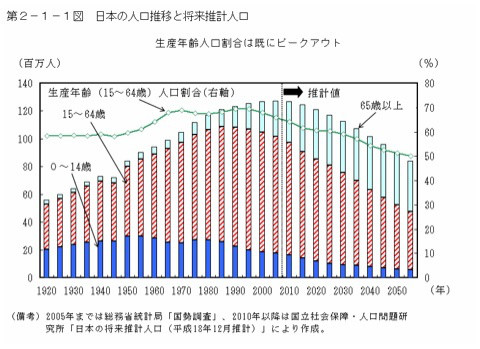近年、少子高齢化と言われてきました。
身近に感じるのは公共交通機関で赤ちゃんをあまり見なくなったことです、、
さて、下のグラフですが1990年代あたりを境に65歳以上の占める構成比が大きくなっております。
反対に0~14歳、15~64歳の占める構成比がどんどん小さくなっております。
日本の土地も限りがあるため人口が増え続けることはできませんが、時代の転換期の真っ只中にあると言えます。

話は変わりますが最近、祖母と話す機会があったのですが、そこで祖母が話していた内容が興味深いものでした。
健康で歩けるような体でないと長生きするのが良いのか考えものですわ。と、、
祖母は背骨を2箇所圧迫骨折しております。
医療の発展・飲食物の衛生管理の向上など寿命が長くなってきました。
良いことである反面、倫理など新たな問題も出てきているように感じます。
In recent years, it has been called low birthrate and longevity.
Feeling it familiar is having stopped looking at a baby not much with a public transportation facility.
Now, although it is a lower graph, the percentage aged 65 and over to occupy is large bordering on per [ of the 1990s ].
The percentage of 0 to 14 years old and 15 to 64 years old to occupy becomes small rapidly on the contrary.
Since land of Japan also has a limitation, population cannot continue increasing, but it can be said that it is in the middle of the turning point of a time.
Although the talk changed, there was an opportunity to talk it my grandmother recently.
Then, the contents about which the grandmother was speaking were interesting.
It is questionable whether it is good to live long, if it is healthy and is not the body which can walk.
My grandmother is doing two-place compression fracture of the backbone.
A life is becoming long by improvement in the hygiene supervision of medical development and food and drink, etc.
While it is good, it is thought that new problems, such as ethics, have also come out.


コメント